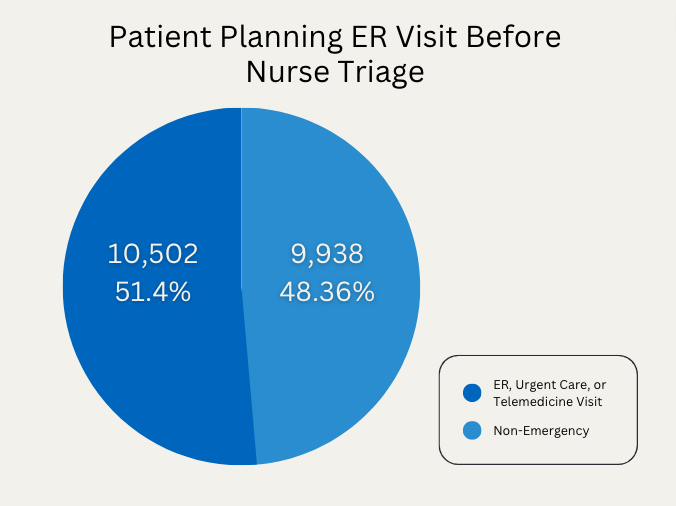Every year, plenty of people mistakenly think their symptoms are serious enough to warrant a trip to the emergency department. However, data shows that in two-thirds of these cases, ED visits are “avoidable” and “not an actual emergency.” While the mindset of “better safe than sorry” may make sense to patients, their unnecessary ER visits can actually be problematic — to them, other patients, and their providers. How do patients know when they really should seek urgent care? Telephone nurse triage is a great solution to help educate patients and ensure that they use the right care option to address their symptoms.
Problems With Unnecessary ER Visits
Before we discuss how nurse triage can help, let’s review the issues that both emergency departments and urgent care clinics can experience when patients frequent them without needing to.
For starters, it bottlenecks the resources of individual providers. The more patients who show up to ask about mild symptoms, the less time and availability those providers will have to see others who need immediate medical attention. These delays in care can lead to seriously harmful — even fatal — medical outcomes.
Another reason that unnecessary ER visits are problematic is because they’re expensive. A single trip can easily cost a patient $2000, while also requiring the time, resources, and revenue of the provider to treat them over others.
It’s important not to blame patients for this. It’s entirely understandable why many of them opt for urgent care or ED visits due to the simple fact that they aren’t medically trained, and they’d rather have the peace of mind from going than to take the risk that their symptoms worsen.
Nurse triage solves this by removing guesswork from the equation.
The Benefits of Nurse Triage
Telephone nurse triage is designed to give patients a means of asking medical questions and sharing their symptoms to determine what level of care is appropriate. Nurses use Schmitt-Thompson triage protocols to evaluate patient symptoms and determine whether they’re severe enough to require a visit to the ER.
These protocols are considered the gold standard for healthcare in the United States, and are updated every year at minimum by a team of medical professionals.
Triage nurses document all patient interactions using sophisticated software before sharing that information directly with referred providers — whether they’re primary care physicians or those at emergency departments. This improves continuity of care for these patients, and makes their responding physicians’ jobs far more efficient.
Most importantly, nurse triage gives patients a resource to evaluate their own health care without feeling pressured by factors like travel time, provider costs, insurance, and general anxiety. And, as we mentioned earlier, the fewer mild cases that ERs have to treat, the more resources they have for patients with time-sensitive needs.
Here are some cases in which our registered triage nurses diverted patients from the ER, thus saving unnecessary visits:
|
Case 1 |
Case 2 |
|
|
The Case |
1-Year-Old Child Had a Seizure |
4-Month-Old Baby With an Ear Infection |
|
The Problem |
A babysitter called our nurses about a child who suffered a 30-second seizure while watching a movie. After the seizure, the child felt normal again, ate dinner, and went to bed. |
A mother called our nurses about her infant’s ear infection, which was not improving despite 5 days of antibiotics. The baby was rubbing his ear, which was discharging liquid. |
|
The Outcome |
After assessing that the child had a history of seizures, was taking anticonvulsants, and did not suffer a recent head injury, our triage nurses recommended home care. |
After our triage nurses assessed the patient’s symptoms, they encouraged the parent to see a PCP within 3 days and continue antibiotic treatment. |
If you’re still wondering how much of a difference nurse triage can make, let’s take a look at some data.
Nurse Triage by the Numbers
From a selection of 20,440 calls processed by TriageLogic’s nurses, 9,938 of them who said yes to going to the ER did not need to go to the ER (48.6 percent!). In addition, many of the remainder calls were resolved with a Telehealth visit with a doctor (890 cases, or 4.4 percent of all callers). Thanks to our continued services, our triage nurses have been able to help patients understand which providers are the right fit to address their specific symptoms and get them the care that they actually need.

Why You Need Nurse Triage
While we’ve been focusing on emergency care and urgent care centers, nurse triage is a valuable resource for all physician offices. These nurses help patients understand the severity of their symptoms and guide them to the appropriate levels of care. They can even use Schmitt-Thompson protocols to evaluate patient telehealth eligibility and schedule appointments on the behalf of those providers. Finally, it’s worth noting that many of the questions and concerns that patients normally ask their doctors can often be answered by triage nurses, making them a simple alternative so that physicians can focus more on direct care.
If you don’t already offer nurse triage services like these, we can help.
Nurse Triage On Call
Nurse Triage On Call refers to our 24/7 nurse triage service that utilizes clinical staff from our call center to address your patients’ needs. They act as an extension of your practice, incorporating doctor-specific preferences and Schmitt-Thompson protocols to create customized paths to care.
All of our nurses maintain the appropriate certifications and training for their phone-based roles, as well as use our EHR-compatible triage software, myTriageChecklist, to thoroughly document each call.
Let’s Discuss a Nurse Triage Program
Looking for your own copy of Schmitt-Thompson protocols, or have questions about outsourcing your nurse triage? Contact us today to get started!
About TriageLogic
TriageLogic is a URAC-accredited, physician-led provider of top-quality nurse telehealth technology, remote patient monitoring, and medical call center solutions. Founded in 2007, the TriageLogic Group now serves more than 22,000 physicians and covers over 42 million lives nationwide.






